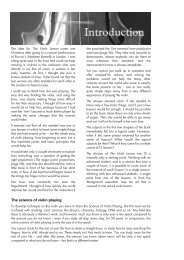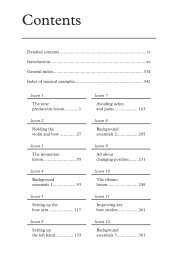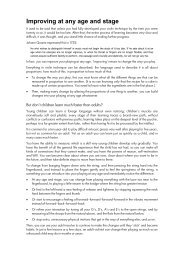Muscles: working from the zero point - Simon Fischer
Muscles: working from the zero point - Simon Fischer
Muscles: working from the zero point - Simon Fischer
Create successful ePaper yourself
Turn your PDF publications into a flip-book with our unique Google optimized e-Paper software.
(1) Suppose you play up <strong>from</strong> <strong>the</strong> A string to <strong>the</strong> E string: you’ve got to go up to go up. If you pull<br />
down as you go up, <strong>the</strong> tone may weaken; <strong>the</strong> bow may slide away <strong>from</strong> <strong>the</strong> bridge; your body<br />
contracts and your breathing is constricted, and so on.<br />
Instead, leng<strong>the</strong>n <strong>the</strong> back as you crescendo up <strong>the</strong> arpeggio, with a feeling of raising <strong>the</strong> chest and<br />
becoming taller.<br />
Keep <strong>the</strong> scroll still, or allow it to rise slightly, with a feeling of buoyancy in <strong>the</strong> instrument so that<br />
it floats on a cushion of air without any hint of dropping with gravity.<br />
(2) Suppose you play down <strong>from</strong> <strong>the</strong> A string to <strong>the</strong> G string: you’ve got to go up to go down.<br />
Leng<strong>the</strong>n <strong>the</strong> back, raise <strong>the</strong> chest, keep <strong>the</strong> scroll still or allow it to rise slightly as <strong>the</strong> strings meet<br />
<strong>the</strong> bow-hair, <strong>the</strong> same as when playing ascending.<br />
One way to avoid pulling down is to have a feeling of <strong>the</strong> string or violin coming up to meet <strong>the</strong> bow. 1<br />
Ano<strong>the</strong>r way to avoid pulling down is to link leng<strong>the</strong>ning <strong>the</strong> back, or raising <strong>the</strong> chest, with flattening<br />
<strong>the</strong> violin. Instead of two unrelated subjects, see <strong>the</strong>m as two parts of <strong>the</strong> same thing:<br />
• Use a certain amount of leng<strong>the</strong>ning your back in order to flatten <strong>the</strong> violin<br />
• Flatten <strong>the</strong> violin in order to leng<strong>the</strong>n <strong>the</strong> back. 2<br />
Examples<br />
Widening at <strong>the</strong> base joints of <strong>the</strong> left hand<br />
Sometimes <strong>the</strong> fingers touch each o<strong>the</strong>r during <strong>the</strong> course of playing, sometimes <strong>the</strong>y do not,<br />
depending on <strong>the</strong> shape of <strong>the</strong> hand and <strong>the</strong> note pattern. It makes no difference, but what does matter<br />
is that <strong>the</strong>re is never any sideways squeezing-toge<strong>the</strong>r (Fig. 78, page 159).<br />
I often remember a student who had an awkward-looking left hand action. I made various suggestions<br />
which she seemed unable to pick up. Finally it came out that she had always thought that no finger<br />
should ever touch ano<strong>the</strong>r finger, so she was trying to keep <strong>the</strong>m unnaturally spread apart all <strong>the</strong> time.<br />
Ano<strong>the</strong>r common misconception is that all <strong>the</strong> fingers should <strong>point</strong> in <strong>the</strong> same direction. Maxim<br />
Vengerov and Joshua Bell are two examples of leading players with hands where <strong>the</strong> fingers do remain<br />
more or less parallel most of <strong>the</strong> time; but for many hands <strong>the</strong> fingers should as often form a fan-like<br />
shape.<br />
Widening at <strong>the</strong> base joints encourages this shape, and gives <strong>the</strong> left hand increased range, flexibility<br />
and mobility.<br />
Leng<strong>the</strong>ning and widening<br />
1 See also Image<br />
of <strong>the</strong> cat,<br />
page 29<br />
2 See also The<br />
tilt of <strong>the</strong> violin,<br />
page 60<br />
[v5.1 12/06/2010 2:10 PM] Lesson 7: Avoiding aches and pains 195






